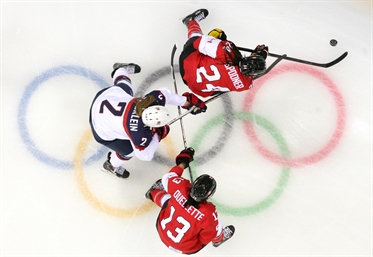Canada-USA, Round 27
Canada-USA, Round 27
Who’s gonna win? Whoever executes

 Canada had the edge in the preliminary-round clash against the United States but the gold medal game starts from scratch. Photo: Andre Ringuette / HHOF-IIHF Images
Canada had the edge in the preliminary-round clash against the United States but the gold medal game starts from scratch. Photo: Andre Ringuette / HHOF-IIHF Images
When Canada and the United States receive their gold and silver medals tomorrow night - who will get which? - it will be because one team played better on this particular night, not because one team is significantly better or worse than the other. Over the course of the last 24 years, Canada has won 16 of 26 games in Olympic and Women’s World competition, but the U.S. won WW gold last year in Ottawa.
Let’s break down the teams and compare:
Goal
This should be a battle between Shannon Szabados (CAN) and Jessie Vetter (USA). No goalie has played more minutes in CAN-USA games than Vetter, whose 560:30 is way ahead of Kim St-Pierre. Vetter has also played in five of the last six gold-medal games since 2008 (not 2012) and has a 4-1 record.
Szabados has played in each of the last four golden games with a 2-2 record. Both goalies have experience and are capable of coming up big. Slight edge to Canada here because of the psychological edge from Vancouver, where Szabados was sensational, and because she is the superior puckhandler.
Advantage: Canada
Defence
Catherine Ward logs more than 23 minutes a game for Canada and Laura Fortino is equally effective in her own end. Although the team defence has contributed only two goals and one assist, it has allowed only three goals in four games and is virtually impenetrable.
The Americans rely much more on their defencemen for offence. They have accounted for three goals and ten assists and have surrendered only five goals in four games. Gigi Marvin and Meghan Bozek lead a group that is perhaps just a touch slower than the Canadians, but neither team has a distinct advantage
Continue readingAdvantage: none
Forward
Clearly this is where the U.S. holds a significant advantage. Younger, faster, quicker, they can move the puck off the rush or establish an effective forecheck that creates turnovers. The top line of Amanda Kessel-Kendall Coyne-Brianna Decker, in fact, represents the top three scorers in the tournament so far.
Canada’s forwards are older and more experienced but rely more heavily on a balanced attack. Meghan Agosta is having a fine tournament, as are Marie-Philip Poulin and Rebecca Johnston. And Hayley Wickenheiser, a step slower and not as strong on the puck as she used to be, is still a force to be reckoned with.
Advantage: United States
Intangibles
By virtue of their superior record in the preliminary round, Canada will be the home team and get last line change. If coach Kevin Dineen tries to match the Poulin line against the Kessel line, as he did so effectively in the game last week, this could prove a significant advantage for Canada.
As well, Canada used long passes and wide passes to great effect in that game. If it can do the same again, the American defence will be tested to the limit.
Both teams have experience and both teams have won the big games, so it will be about muscle memory: Does Canada’s Olympic memories from 2010 conquer the Americans’ 2013 Women’s Worlds memories?
Advantage: Canada
Bottom Line
The pressure is more on the Americans to win. They are, really, the better team, but “should” win and “have” won are two different beasts. Count on it being a one-goal game and Canada coming out on top. No, wait—the U.S.! The U.S. for sure. Or Canada.
Back to Overview







































